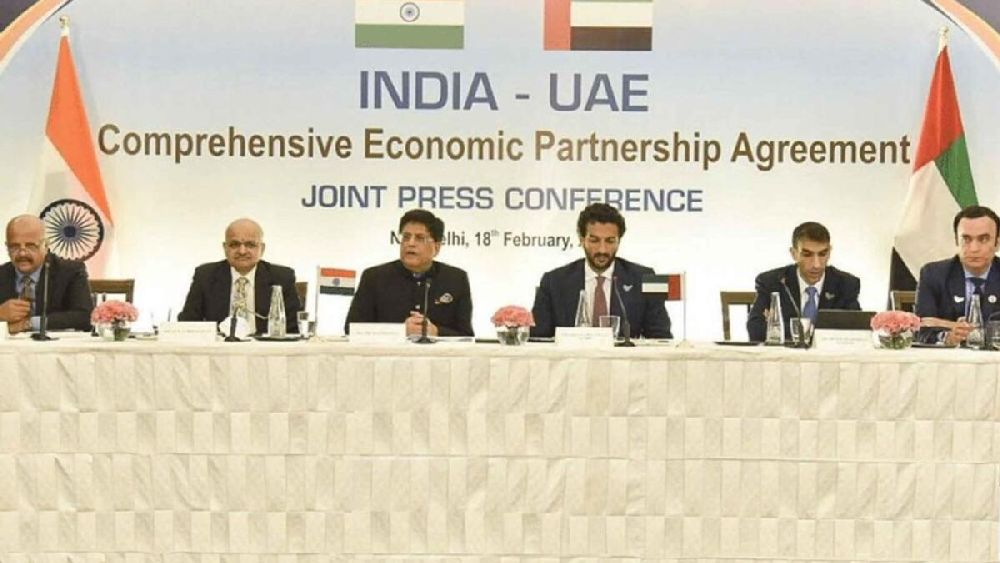
.
The Indian Ministry of Commerce and Industry has published the Comprehensive Economic Partnership Agreement (CEPA) between India and the UAE. The document was released on Sunday by the Indian Embassy, Abu Dhabi.
His Highness Sheikh Mohamed bin Zayed Al Nahyan, Crown Prince of Abu Dhabi and Deputy Supreme Commander of the UAE Armed Forces and Indian Prime Minister Narendra Modi met virtually on February 18, when the agreement was signed by Abdullah bin Touq Al Marri, the Minister of Economy, UAE, and Piyush Goyal, the Indian Minister of Commerce. The CEPA was finalised and signed in a record time of just 88 days.
Acknowledging 50 years of strong bilateral ties, both leaders agreed on a roadmap for a future-looking partnership between the two countries, strengthening the Comprehensive Strategic Partnership with opportunities for greater depth and breadth of cooperation. The roadmap will ensure that the two countries work together even more closely to address the shared global challenges, achieve shared objectives and build a robust and resilient relationship that is future ready. It will promote the development of new trade, investment, and innovation dynamics, and intensify bilateral engagement in diverse areas.
The partnership between the two countries led to the joint work on several agreements and Memorandum of Understanding in areas including the Economy, Climate Change and Houbara Conservation, Industries and Advanced Technologies, Low Carbon Hydrogen Developments and Investments, Food Security, Financial Services and Issuance of India-UAE Joint Stamps.
The document is classified into various chapters with annexures attached to each of them. The chapters cover Trade in Goods; Rules of Origin; Sanitary and Phytosanitary Measures; Technical Barriers to Trade; Customs Procedures and Trade Facilitation; Trade Remedies; Trade in Services; Digital Trade; Government Procurement; Intellectual Property; Investment and Trade; Micro, Small and Medium-sized Enterprises (SMEs); Economic Cooperation; Dispute Settlement; Exceptions; and Final Provisions.
“The India-UAE cooperation is set to achieve greater heights, truly a partnership like no other,” tweeted the Indian Embassy. The agreement recognises the strong, historic, and developing relationship between the two countries and the friendly ties that exists between their people. It aims to strengthen these links through the creation of a free trade area, thus establishing close and lasting relations.
CEPA is conscious of the respective rights of the two nations and “obligations under the Marrakesh Agreement Establishing the World Trade Organization, in a manner conducive to the development of regional and international cooperation, thereby contributing to the harmonious development and expansion of world trade.”
It is also mindful of the dynamic and rapidly changing international environment brought about by globalisation and technological progress that presents various economic and strategic challenges and opportunities to the two nations.
The agreement aims to establish a clear, transparent, and predictable legal framework that supports further expansion of trade. It is determined to strengthen economic and trade relations between the UAE and India for their mutual benefit through trade liberalisation in goods and services, enhance investment facilitation and cooperation and encourage transfer of technology, strengthen bilateral relationship, encourage creation of new employment opportunities, raise living standards, and improve the general welfare of their populations.
The two nations, the document states, are convinced that the establishment of a free trade area will provide a more favourable climate for the promotion and development of economic and trade relations between them. It aims to facilitate trade by promoting efficient and transparent customs procedures that reduce costs and ensure predictability for their importers and exporters.
CEPA is determined to support the growth and development of micro, small and medium-sized enterprises by enhancing their ability to participate in, and benefit from the opportunities created by the agreement.
It recognises their right to regulate and to preserve the flexibility of the two parties to set legislative and regulatory priorities. It also recognises the need to protect legitimate public welfare objectives such as health, safety, environmental protection, conservation of living or non-living exhaustible natural resources, integrity and stability of the financial system, and public morals, in accordance with the rights and obligations provided in the agreement.
ALSO READ:
- UAE-India Investment Forum: Indian businesses can thrive in UAE's innovation-driven landscape, say experts
- UAE-India Investment Forum: Companies set to benefit as soon as CEPA comes into effect
- UAE-India investment forum: CEPA to trigger investment flows, create new opportunities for key sectors
- UAE soft power on show amid twin celebrations of golden jubilee and India’s 75 years of independence
Further, the agreement is conscious that a bilateral relationship between them will contribute to trade expansion and promote greater regional economic integration, not only between the UAE and India, but also in the region. The agreement will open a new era for the relationship between them.










